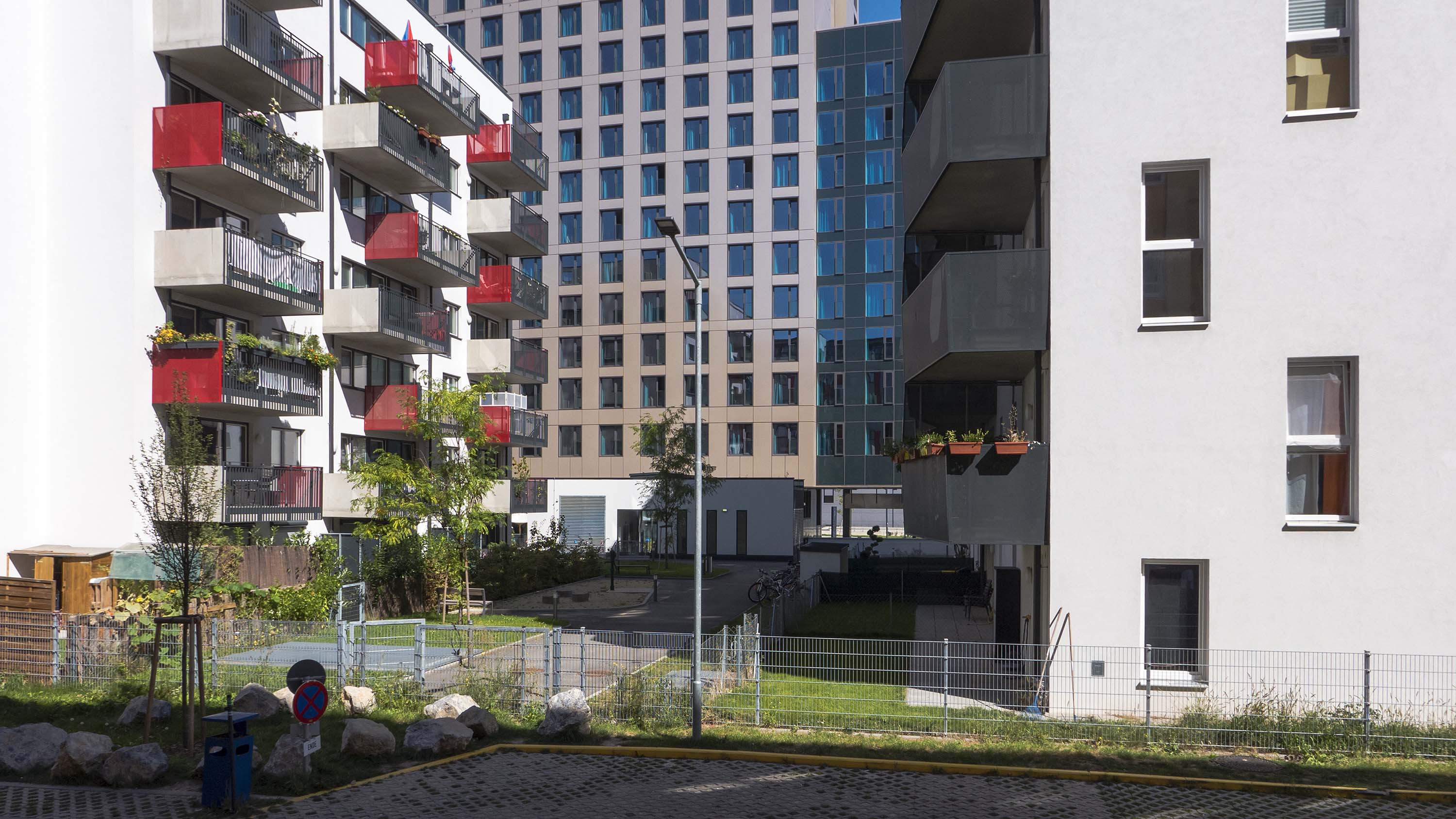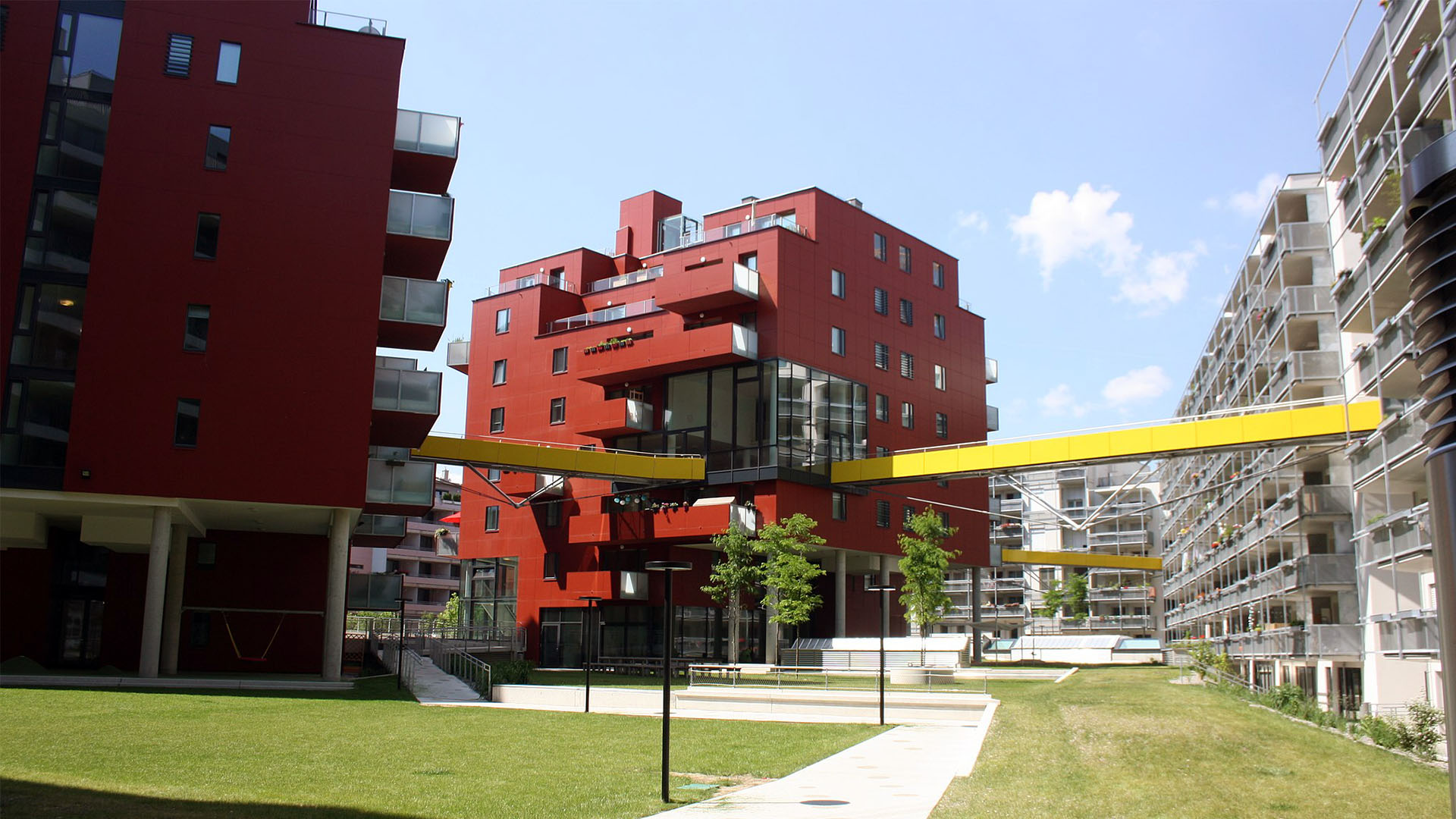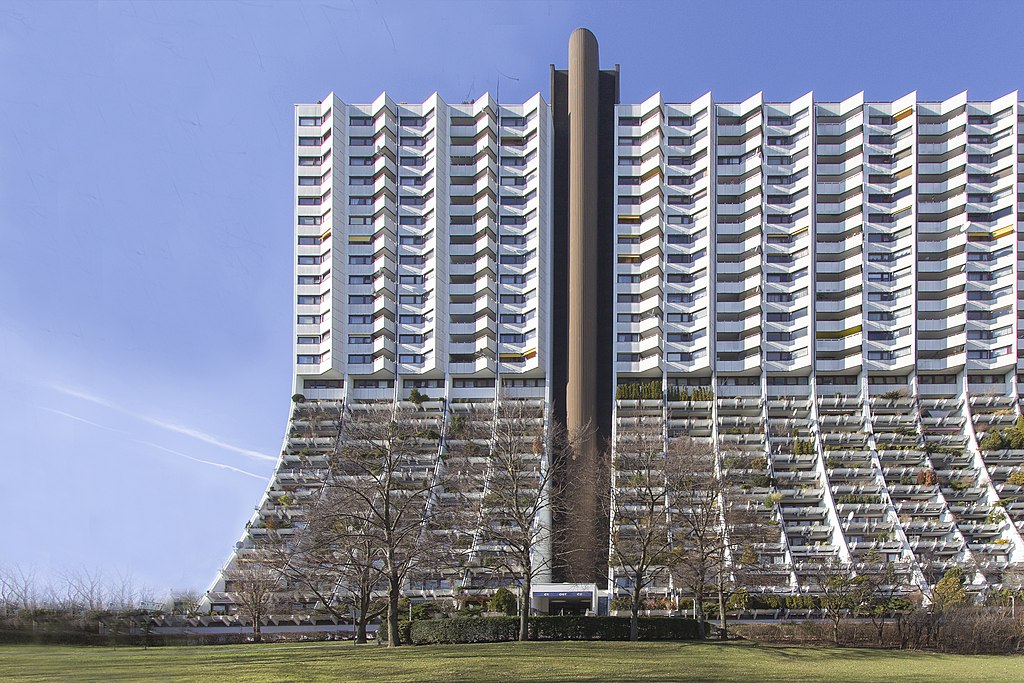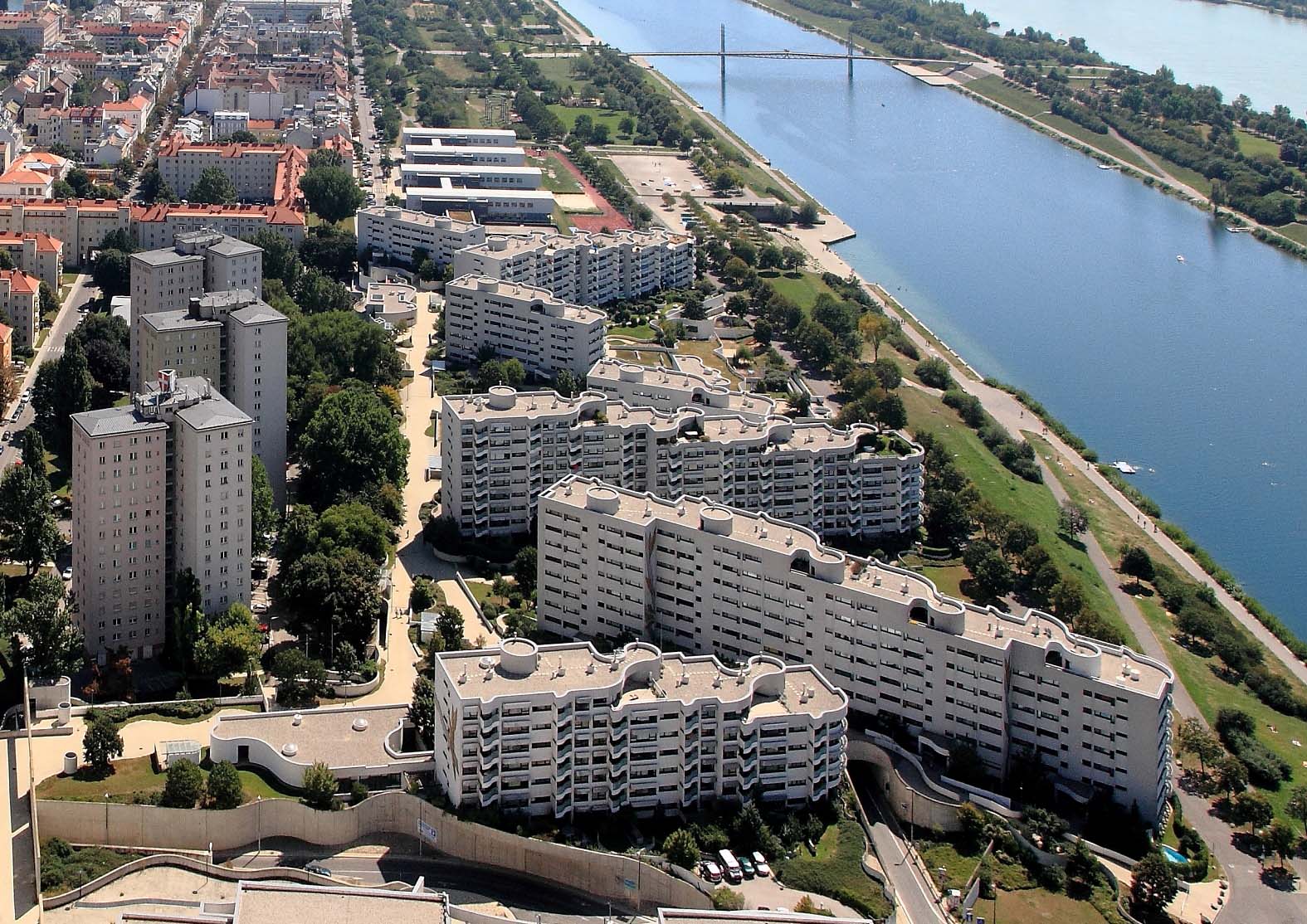
Photo by Christopher Chiu for Eurozine
Article 5 of Austria’s Basic Law of 1876, which sets forth that ‘property is inviolable’, decorates the facade of the temporary quarters of the Austrian parliament.
The slogan ‘housing is not a commodity’ is a statement which, under the present political conditions, is unfortunately more wishful thinking than reality. The acquisition of housing for the purpose of capital increase and wealth accumulation without the intention of use is not considered to be evil speculation, but as a reasonable investment of money at a time when savings accounts yield low interest. It is obvious that rents will inevitably rise as more and more profiteers become involved, but the issue remains little discussed.
This article takes a look at the Austrian model of the so-called ‘Vorsorgewohnung’ (literally ‘provision apartment’ or ‘nest-egg investment property’), a tax saving investment product primarily aimed at small private investors. The model offers the opportunity for dazzling returns, especially for developers, and is a clear example of the financialization of the housing sector.
Vienna as a model city?
Vienna is considered a model city in terms of public housing. While this may be gratifying, it should not be forgotten that since the global financial crisis of 2007-2008 there has been a (counter)trend towards housing ownership, especially ownership for investment purposes. Not only has the ratio of subsidized to privately-financed housing almost reversed in the last decade (whereas 80% of building permits were in the state-subsidized sector in 2008, the privately-financed sector predominated at 70% in 2017). The privately-financed sector is also seeing more and more apartments being built for and advertised especially for investment, labelled as ‘Vorsorgewohnung’ (VSW), especially for small private investors.
According to a market study, every tenth residential housing construction project undertaken in Vienna in 2015 was exclusively for building investment properties. According to the first Vienna VSW market report published by a real estate service provider, the number of new-build apartments purchased for the purpose of long-term third-party letting increased by 71% from 2016 to 2017. In 2018, construction was at its most intense in the privately-financed sector, with 446 new construction projects documented in Vienna (a total of 25,886 owner-occupied and VSW).
The investment construction sector, in which profit-oriented real estate companies compete for investors, is seeing more and more new large-volume construction projects (i.e. projects including 500 residential units or more), which are destined variously for mixed-use projects or as investment properties. But short-term, serviced rental apartments (such as those in the former Philips office building on Wienerberg) are also being sold as VSWs.
It’s a buyer’s market
The online listings market also gives us an idea of how normal it has become to buy housing for investment purposes. On some search portals, investment apartment has already become established as a search category in its own right.
According to the real-estate website ImmoScout24, in April 2019 24% of the apartments for sale in Vienna (2,442 of 10,053 apartments as of 2 April 2019) were investment properties. A survey conducted by the same website in 2015 showed that almost a quarter (21,4%) of 2,161 prospective buyers were looking for a residential property as an investment. If one believes the figures from a recent study commissioned by Erste Bank, 22% of Austrians already possess a ‘savings product property’.

The projects of Sonnwendviertel in Vienna. Photo by Gugerell from Wikimedia Commons Gugerell / CC0
The fact that an increasing number of private households are buying a home for investment purposes is usually explained as an effect of the financial crisis of 2007 and low levels of savings and interest rates. There is also some merit in the explanation that the current appetite for investment properties hinges on a lack of confidence in equities, a fear of devaluation of money and a ‘lack of alternatives for equity investment’.
But such explanations overlook the social conditions that made it possible for real estate to be seen as a financial product—conditions that permitted an investment-oriented housing sector to emerge in the first place.
Although we won’t question the popular justifications for the flight of capital into real estate, following the relevant literature we will argue that the naturalization of real estate investments can only be adequately understood against the background of the financialization of socio-economic relations.
Financialization
Financialization is generally used to refer to processes and structural changes in contemporary capitalism that accompany the ascendancy of financial market actors and the ‘spread of a (financial)market-oriented rationality’ through all areas of life. From a regulatory perspective, financialization is understood as a ‘regime of accumulation in which finance dominates’ and profits increasingly come from financial transactions rather than material production and wage labour.
This development is attributed to the opening-up and deregulation of national financial markets, but also correlates with a number of other changes: the rise of institutional investors (pension funds, insurance companies, investment funds, property funds, hedge funds); the development of new ‘innovative’ financial products; changes in the logic of financing; the extension of credit and investment activity into private households; the politically-motivated inculcation of financial self-responsibility in individuals (‘responsibilization’).
In terms of Marxist analyses of capitalist spatial production, financialization is also defined as a new cycle in the process of capital circulation. The central assumption here is that in financial capitalism the surplus (money) capital, swollen to a ‘great wall of money’ (Aalbers) and looking for profitable investment, ‘switches’ from the primary capital cycle of normal commodity production (oriented towards a rapid realization of value) into the ‘secondary capital cycle’ of the built environment. And the same is true of cycles derived from this motion in which the long-term asset property turns into a short-term tradable financial product.
Wherever loans used for the purchase of land or properties become commodities in themselves, and where their outstanding returns (from the lending of money to the construction industry and to the purchasers of real estate) come to be regarded as safe and lent as fictitious capital or resold in the form of securitizations (as was the case in the subprime crisis), one can speak of ‘financialisation in the true (narrower) sense’.
But the production (construction and financing) and consumption (purchase and use) of housing may also be permeated by financialization, and the Austrian rental investment product ‘Vorsorgewohnung’ is a particularly good example. In order to more precisely define this type of financialized real estate, we first need to take a differentiated view of investment properties.
Types of investment apartments
There are different types of privately owned properties, depending on the logic that underlies their production, purchase, use and management. If market-oriented housing is acquired for private use (i.e. for habitation), its owners are interested above all in the use-value and utility of the dwelling, which, as with all commodities, is ‘realised only in use or consumption’.
Although the hope that its value might increase may play a part in the purchase, as long as the apartment itself is actually being used, then its exchange value remains largely irrelevant. However, significant price increases can lead to owners selling their residence (as has been the case with residents of central London who leave their careers to fulfil lifelong dreams of living in a house in the country or in a Moroccan riad). Owner-occupied residential property can thus turn out to be a good investment in retrospect – which does not, however, make these apartments investment property and their owners not investors.
Only when owners buy residential properties with the intention of selling or letting them we should speak of investment property. The buyer’s need for housing is not a factor in the purchase; the owner is only interested in the property’s exchange value. The buyer invests capital (money) in a commodity (housing) in order to sell it (with or without adding value through improvements) for as much profit as possible, which is speculation in the proper sense of the word.
Speculation itself is based on the belief that housing prices will continue to increase and that there will always be a ‘bigger fool’ who will be willing to pay a higher price. The selling price is ‘only calculated on the basis of the expected willingness of third parties to buy’, so it is based on a general assessment of the state of the market and not on the value of the property, which is a function of the costs of production (construction and land costs) and any renovations undertaken.

The projects of Sonnwendviertel in Vienna. Photo by Daniel-tbs from Wikimedia Commons Daniel-tbs / CC BY-SA
Currently, in Vienna (as in many other European cities), the business model of sitting on a property without letting it is a profitable one. In order to be able to sell an apartment at any time at a profit (and because a rented property can cause a depreciation in its value), some property-owners (i.e. those who can afford it) refrain from renting at all. Housing bought for such speculative purposes (or, at the very least, kept vacant in order to retain its value) is not only dead capital (i.e. capital that does not yield a continuous return), but also dead space since people who need it (especially during housing shortages) cannot make use of it.
Normally, however, investment properties are bought to turn a profit through renting them. In contrast to buying a house, which is a simple act of exchange, renting property constitutes a capital cycle, one similar to lending money. In this case, what is lent is the housing commodity, for which the landlord receives interest in the form of rent. A rental property purchased for the purpose of letting (buy-to-let) functions as interest-bearing (commodity) capital, which should yield interest like a savings book. However, unlike a savings book (money loaned to a bank), a large amount of money is fixed in a long-term way into a particular point in space when buying a house.
This is why it takes a relatively long time for the capital invested to be regenerated, and for rental housing to generate a profit. This is especially the case when the purchaser has borrowed money to buy a house, which they have to pay back with interest.
Now one might assume that money is only lent to finance an investment property if the buyer does not have sufficient equity. Paradoxically, however, many buyers choose to borrow even when they are able to cover the entire purchase price with their own resources. This is often done because there are certain tax advantages linked to debt financing (e.g. loan interest can be tax-deductible), which is how we have arrived at the type of investment apartment labelled in Austria as a ‘Vorsorgewohnung’. Here, too, buyers want to see returns on their capital investment through rental income and an increase in the value of the property. But tax advantages also help improve profitability.
With investment housing of the VSW type, the key idea is that one’s tax bill can be reduced or optimised through the purchase of investment properties. Even in the case of a normal investment property, a certain amount can be deducted against income tax (claiming pro-rata acquisition costs, real estate transfer tax, brokerage commission, maintenance expenses, administrative and consulting costs as business expenses). However, in the case of a VSW investment property, loan interest is deductible, and, crucially, 20% sales tax can be recovered from the purchase price by claiming it back as input tax.
The idea of home ownership as being in some sense self-financing is also significant, as the monthly instalments of the loan repayment are covered by monthly rental income. But the beautiful dream of the self-financing retirement property only becomes a reality if the properties, which are usually purchased from a plan or picture, are actually completed, rented out successfully, and if the owners can continue to service their debt in the event of rental default or interest rates increasing on their loan. Otherwise, the investment property must be sold and any sums claimed as input tax must be refunded to the taxman.
Peculiarities of financialized housing
The purchase of housing for the purpose of renting them is not a new thing. What is relatively new, however, is that properties are designed, produced, distributed and marketed like a financial product, particularly under the label ‘Vorsorgewohnung’. This product may have undergone a change since the 1990s in the wake of a changing interest rate environment (i.e. following the ECB’s low interest rate policy) – namely from a tax-savings model, which is attractive to top earners, to an investment model for a broader (and now also debt-based) middle class. But regardless of this shift or expansion, the investment property type VSW has some special features that allow it to be classified as financialized housing.
A significant feature is the logic that underlies the production of housing: ‘from the very beginning, the property [is] intended exclusively as a means of earning money’. In principle, every apartment can become an investment property (the transformation takes place solely by virtue of the fact that the buyer becomes a ‘real’ entrepreneur under tax law and does not vote for small business regulation). But the advent of the investment construction sector has meant that a new stage of capitalist housing production has been reached, wherein housing is no longer built for users but for investors. Although the use value remains a necessary prerequisite for the capitalization of the commodity dwelling (more precisely, for its rental value), the yield value, i.e. the rent that can be obtained from property, is now front and centre from the very beginning.
If apartments are already designed as interest-bearing capital during planning, housing becomes a commodity as capital. What is put into circulation is not the commodity dwelling, but the dwelling as capital, which is to yield returns (namely, interest in the form of rent) through future lending.
Another central characteristic is the decoupling of or maximizing the distance between object and owner. Trouillard also speaks of ‘maximum intermediation’, which refers to the interposition of additional (and to be paid additionally) services. Many providers in Vienna offer a comprehensive ‘carefree package’ that includes rental, administration and maintenance costs, but also support with tax returns and sometimes computational processing via a rental pool. In other words, ‘The investor will be relieved of all work related to the construction, renovation and management of the property’.
A certain distancing from the property is already built into this mediation and purchase process, given that the apartments are sold before completion, i.e. without inspection from a picture or plan. But long-term decoupling is only achieved through professional management of the asset. Not only is it no longer necessary (and for many, no longer desirable) for investors to inspect their investment property themselves, they also don’t see their tenants any more.
If all contact with housing is reduced to monthly account receipts and an annual cost statement for one’s tax return, property has shed all its physical presence and demanding burden for the owner. In other words, it has reached its true capitalist form.

Wohnpark Alterlaa Liesing Photo by Viennaphotographer from Wikimedia Commons Viennaphotographer / CC BY-SA
Another element closely woven into this lack of contact is the avoidance of emotionalization of the property. A property that is to function as a pure investment must be decoupled from the personal preferences and needs of the buyer. That is why investment experts can only see a disruptive factor in the idea of private use.
As a real estate agent put it in a business magazine: ‘Private investors should avoid the question of whether they would want to live there themselves. This creates an emotional connection with the property: a very unfavourable precondition for an investment. […] Only location, net asset value, return on investment and yield potential should be decisive factors in the decision to purchase’.
Buyers are encouraged to consider a property solely from an investment point of view. As no emotional relationship with the property should be allowed to develop, any personalization work, i.e. the individual furnishing and decoration of the apartment, is to be avoided. It is said to be a ‘mistake’ to ‘be influenced by one’s own tastes and desires’. Therefore, co-determination in the selection of the kitchen, the floor, tiles, etc. is not provided for in new-build investment apartments. It all boils down to a remote financialized relationship in which owning an apartment actually feels like owning a financial product such as a savings book or a security.
Last but not least, the ‘Vorsorgewohnung’ investment product is closely linked to credit financing. It is true that even in the nineteenth century the housing rental business was built on credit and the rents have been used for years to finance loans. But, whereas in earlier periods it was a small elite of capital owners who benefited from the housing market, today development is characterized by the ‘financialised masses’ of the middle class.
However, a buyer’s willingness to finance an investment property from external sources can be motivated differently depending on the interest rate and income situation. Whereas in the 1990s (when mortgage interest rates were as high as 8%), the wealthy middle class was encouraged to borrow to save on income tax. Today, with historically low interest rates, people with average incomes and no large reserves feel encouraged to borrow.
Genesis and framing – an invention of the banking world
The genesis of the Austrian rental investment product ‘Vorsorgewohnung’ is still largely in the dark, but what can be said with certainty is that it is an invention of the banking world. The business and investment model VSW was developed in 1990 by leading bank representatives. Whereby the inventors were able to rely on existing provisions of Austrian income and VAT tax law.
It would, thus, be too simplistic to ascribe the construction of this product the banks alone. Even if the Austrian state has never actively promoted the construction of investment properties, it is indirectly involved in the production of both supply and demand for this rental investment product through its tax legislation.
The inventors expected the introduction of the financial product VSW to bring about several benefits. It was intended to attract surplus capital from private households, to boost the construction industry and, above all, to bring new business and profits to the banks.
It is no coincidence that banks have been central to the implementation of this rental investment product, as they benefit thrice over:
they make money from the construction of the apartments, through loans to the developers;the sale of the apartments: through loans to the buyers; commission from the developers if they act as brokers and, if they act as project developers, by skimming off added value from production;and finally, from the brokerage of the apartments, by charging a commission from tenants.
It is therefore not surprising that banks and their subsidiaries (such as Raiffeisen Vorsorge Wohnung GmbH; s REAL; Bank Austria Real Invest; and, until the 2000s, Constantia Privatbank) have been among the largest providers of investment properties in Vienna since the 1990s.
As with the introduction of any new product, marketing — and therefore framing — is key. ‘Cleverly here a single word [Vorsorgewohnung] combines the object ‘Wohnung’ (apartment), as the means of investment, with ‘Vorsorge’ (making ready or laying in provisions, in particular for retirement) as the goal of the investment’.
The word ‘Vorsorge’ establishes a positive interpretative frame. One takes precautions, makes preparations for harder times as well as the future in order to achieve financial security. The acquisition of investment property is coded as a foresight, a wise action aimed at our future well-being. Preparing for old age and retirement through buying property is seen as right and good.
The word ‘Vorsorge’ provides moral legitimacy for what can also be (negatively) interpreted as accumulation for its own sake, striving to maximize individual profit or as a model of housing supply denuded of social solidarity.
Responsibilization
Of course, when applied to wealthy households, ‘Vorsorge’ is a euphemism. Such households do not need investment properties as a safeguard. Due to their size, the apartments are not suitable for self-use either. Rather, they only serve to increase wealth and shore up the value of capital. For the less well-off middle-class the narrative of ‘provision for old age’ also sets in motion a subjective feeling of insecurity and fear (which is ultimately to be exploited).
Especially for people with average income, without large savings and without property (i.e. tenants), the VSW business shows itself to be a business of fear (of pension cuts). Seen from there, the term ‘Vorsorge’ is closely linked to broader social and political processes, in particular the political discourse on personal responsibility and private pension provision.
The VSW investment model can therefore be associated with ‘responsibilization’, a governance rationality that aims to make citizens independent of state insurance systems by strengthening their financial self-sufficiency and to turn individuals into strategically calculating ‘investor subjects’.

Wohnpark Neue Donau in Vienna. Photo by Bwag from Wikimedia Commons © Bwag/CC-BY-SA-4.0
Since ‘the social order is increasingly constituted according to mechanisms of capital valorisation’, individuals are called upon to internalize the logic of financial markets, develop investment strategies and make use of financial services. This development also entails a transformation of savings behaviour: instead of relying on savings balances or state social security services, individuals should participate in the stock market and build up their wealth by putting their money into (investment) property.
‘Investor knowledge’
The investment behaviour demanded by this economic environment not only presupposes a capitalist disposition, a calculating spirit of individual profit maximization – which, by the way, is not a natural thing, but, as Bourdieu emphasizes, the product of a long and collective history inscribed in social and cognitive structures. It also presupposes access to certain services and information.
On the one hand, relevant ‘investment knowledge’ must be disseminated in the media. Reports on ‘investing in concrete gold’ and the financial product VSW are disseminated in business magazines (print, radio and TV) as well as in the property sections and special supplements of daily newspapers. The public investment discourse also includes handbooks on investing in real estate and advice literature on retirement provision (from consumer rights organizations, among others), as well as articles and videos on websites of banks and other financial service providers.
On the other hand, the infrastructure for financial and investment advice, which has grown strongly over the last decades, is of central importance. Professional financial and investment advisors teach individuals how to invest (‘life planning is financial planning’) and provide advice to those who feel overwhelmed by the variety of investment products.
This advice infrastructure, which aims to turn as many people as possible into investors and to direct the accumulated capital of private households (‘money that isn’t at work’) towards capital and real estate markets, is also central to the trade of the rental investment product VSW.
The investment property (sub)market that has emerged around VSW represents a peculiar amalgam of financial services and the construction industry. Builders and estate agents have become highly specialized financial service providers. Conversely, financial service providers have also become builders of investment homes. Since everything needs to be handled smoothly, many providers (as with car retailers) offer the financing themselves, including the model calculations for yield.
Who is really turning a profit
What is sometimes forgotten about these (often overly optimistic) yield calculations for investors is that the construction and trading of investment apartments is the big business itself. In a certain sense, it is a double business, especially as builders and buyers (should) both benefit.
The central promise of the sales pitch, namely that the ‘safe’ or even ‘risk-free investment’ in residential real estate will create a continuous stream of ‘additional income for the future’, can therefore be understood as a hegemonic tale told by the producers, which obscures what lies at the heart of the business model of investment housing. What remains hidden is precisely the fact that this model is not about procuring profits for small investors (which accrue gradually and are usually only to be enjoyed in the distant future) but rather about turning a quick and thick profit for the project developers.
The production of investment properties is a perfect example of accelerated capital circulation. In contrast to the conventional rental business (where the builder is the owner and landlord), here the capital invested in construction should flow back with profit as quickly as possible and at a single stroke. The project developer (this can be a construction company, a project company, the subsidiary of a bank or a consultancy firm) focuses on the rapid sale of the apartments rather than the slow, long-term business of collecting rent, thereby passing on all risks to the buyers.
In order to sell quickly, the builder must also invest more money in advance in marketing and digital visualisation. Fostered by online advertising and coordination tools, and the possibilities of digital visual representation, apartments are often sold before ground is broken on the building site. As a rule, apartments are sold to small and medium-sized private investors, unless the entire construction project has already been transferred into the hands of a major international investor.
What is important is that the investors pay considerably more for a property than the builder has paid out for it. Whereas classic landlords and owners of tenement buildings only have to pay construction costs (including land acquisition), investors pay the price that can be realized by the developers on the market.
To make this difference a little more tangible: in Vienna in 2018, the upper limit of building costs for subsidised housing (which is often qualitatively superior to privately financed housing) was 1,800 Euro/m2. For the privately financed property and investment housing segment, the city-wide average offering price in the same year was 5,230 Euro/m2.
Because privately financed housing construction isn’t necessarily any more expensive than subsidised housing, we can conclude that the sale price of an investment property is more than twice as high as the overall construction costs. This is a hefty profit, which explains the recent gold-rush mood in the privately financed construction sector – but also the rising rental prices throughout the 2010s, especially since the builders’ profits have to be recouped through renting.
The tenants always have to pay
If the rental price is not calculated based on the construction costs (as in conventional rental business), but rather the much-higher purchase price (including the builders’ profits), then the primary losers are the tenants, who face higher rents.
It is true that in Vienna (in contrast to other major European cities) the relatively large segment of communal and subsidised rental housing (43% of main residences) has a price-suppressing effect on the private rental housing sector (something which is the subject of frequent complaints by profit-oriented developers and landlords). In the end, however, it is always the tenants who have to pay for the (double) business of the investment property industry.
In the wake of the global financial crisis, the influx of over-accumulated capital into the secondary capital cycle of the built environment has caused sale prices per square meter in Vienna to rise rapidly. Between 2009 and 2017, prices for new-build apartments rose by 64%. For used apartments in historic old buildings the figure was 100%.
Although investment properties absorb only one part of the capital which is seeking investment, the rapidly growing privately-financed sector has a knock-on effect on the entire housing system. In Vienna, this affects not only the non-profit sector, but also the regulated private rental housing market (pre-1945 buildings).
The explosion of land prices has made the construction of non-profit housing more difficult and expensive and (together with the low interest rate policy of the European Central Bank) has led to increased engagement of non-profit housing companies in the privately-financed sector. The rise in land prices has also led to an increase in rents in old buildings since Vienna’s location surcharge is calculated in relation to land prices.
Contrary to what the profit-oriented real estate industry might argue, increased construction activity in the privately-financed sector does not contribute to an easing of the housing market, but rather to a shortage of affordable rental and sales apartments. Without access to inherited wealth, property ownership is now all but out of reach for average earners. Low- or middle-income households are increasingly being pushed out of central urban areas.
Social blindness and the dissolution of solidarity
The fact that for-profit construction companies are concerned with profit and not with the equitable distribution of the social good ‘housing’ does not need to be emphasized. The social blindness, which is otherwise (abstractly) attributed to the market, is manifested quite concretely when it comes to VSWs. It is produced structurally at the micro level, mainly through delegating the letting to service providers.
If contact with the tenants is no longer required, certain moral questions no longer arise. Can I expect the single parent to pay me more than half of her or his monthly income for 50 square meters? Would I not do better to make the apartment available at a lower rate to a friend in need? Would I be prepared to pay the price that I am asking?
The delegation of rental activities to a service provider not only creates indifference towards tenants and their lived economic situation, it also eliminates any opportunity for socially responsible letting or price-setting. This distant, financialized relationship to housing in which housing is encountered purely as capital dissolves social solidarity.
However, the spread and normalization of financialized small-scale landlords also means that alternatives to profit-oriented housing can be considered less and less. The more people become investor-landlords in a society, the less likely it is that housing will be seen as a social good and as a basic need that should not be exploited.
Property investors are per se positioned on the side of capital. As utilitarian-capitalist individual agents, on whom ‘the economic field […] imposes the goals (individual enrichment) and the “reasonable” means to achieve them’, they can only note increasing property prices with satisfaction and joy. They can only see their own advantage, but not their own contribution to the negative effects at the collective level.
Conclusion
The acquisition of residential property for the purpose of capital accumulation and pension provision has become an essential part of the neoliberal self-understanding of western middle classes. This can be lamented from the standpoint of a pure critique of capitalism, or of the market), or indeed – as here – from the point of view of a pragmatic critique that elucidates the unintended consequences of a cultural practice. However, the criticism, i.e. the spelling out of the conditions, implications and consequences of capitalist small-scale landlords, should not lead to a condemnation of property investments and small investors, but to thinking about what a better investment practice might look like.
The question is whether at least a part of the wealthy middle class would not be willing to invest its accumulated capital in self-organized construction groups, small cooperatives and foundations committed to social ideals.
However, such an alternative system of property investment presupposes that investors are aware of socially sustainable housing projects. In the future, this awareness will be an important means by which alternative developers and builders can gain access to the wealthy middle class’s surplus capital. In order to optimize this mediation process, professional investment consultants would also have to be brought on board to define criteria for socially sustainable real estate investment.












